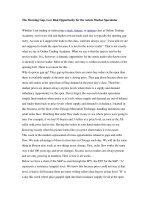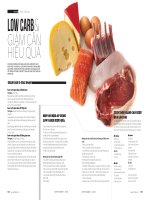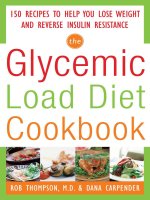Ketogenic diet cookbook deliciuos low carb recipes for fast weiht loss
Bạn đang xem bản rút gọn của tài liệu. Xem và tải ngay bản đầy đủ của tài liệu tại đây (580.22 KB, 125 trang )
Ketogenic Diet
Cookbook
Quick, Easy, and Delicious
Low Carb Recipes for Fast
Weight Loss
Savannah Gibbs
© Text Copyright 2017 by Savannah
Gibbs - All rights reserved.
This document is geared towards
providing exact and reliable information
in regards to the topic and issue
covered. The publication is sold with
the idea that the publisher is not required
to render accounting, officially
permitted, or otherwise, qualified
services. If advice is necessary, legal or
professional, a practiced individual in
the profession should be ordered.
From a Declaration of Principles which
was accepted and approved equally by a
Committee of the American Bar
Association and a Committee of
Publishers and Associations.
In no way is it legal to reproduce,
duplicate, or transmit any part of this
document in either electronic means or
in printed format. Recording of this
publication is strictly prohibited and any
storage of this document is not allowed
unless with written permission from the
publisher. All rights reserved.
The information provided herein is
stated to be truthful and consistent, in
that any liability, in terms of inattention
or otherwise, by any usage or abuse of
any policies, processes, or directions
contained within is the solitary and utter
responsibility of the recipient reader.
Under no circumstances will any legal
responsibility or blame be held against
the publisher for any reparation,
damages, or monetary loss due to the
information herein, either directly or
indirectly.
Respective authors own all copyrights
not held by the publisher.
The information herein is offered for
informational purposes solely, and is
universal as so. The presentation of the
information is without contract or any
type of guarantee assurance.
The trademarks that are used are without
any consent, and the publication of the
trademark is without permission or
backing by the trademark owner. All
trademarks and brands within this book
are for clarifying purposes only and are
owned by the owners themselves, not
affiliated with this document.
Table of Contents
Chapter 1: Introduction to the Ketogenic
Diet
Principles of the Ketogenic Diet
What to Eat and What to Avoid on a
Ketogenic Diet
Health Benefits and Risks
Chapter 2: Ketogenic Diet Breakfast
Recipes
Bacon and Eggs
Cream Cheese Pancakes
Breakfast Taco Bowl
Hot Cereal
Chicken and Asparagus Frittata
Spinach Quiche
Vanilla Flax Bread
Chapter 3: Ketogenic Diet Lunch
Recipes
Pepperoni Pizza
Cheesy Cauliflower
Tuna Burgers
Ginger Beef
Pork Chops
Creamy and Cheesy Soup
Chicken Salad
Chapter 5: Ketogenic Diet Snack
Recipes
Creamy Blackberry Smoothie
Guacamole
Deviled Eggs
Italian Antipasto
Stuffed Mushrooms
Jalapeño Poppers
Mango Salsa
Chapter 5: Ketogenic Diet Dinner
Recipes
Seafood Stew
Sausage and Eggplant Parmesan
Beef Curry
Grilled Steak
Shrimp Taco Salad
Chicken Breasts with Creamy Sauce
Turkey Casserole
Broiled Lemon Tilapia
Chapter 6: Ketogenic Diet Dessert
Recipes
Blueberry Cobbler
Chilled Lemony Treat
Pumpkin Custard
Peanut Butter Cream
Coconut Candy
Strawberry Cheesecake
Conclusion
Check Out My Other Books
Chapter 1: Introduction to
the Ketogenic Diet
If you've tried calorie-counting diets and
programs that come with complex
recipes and pre-packaged food, the
Ketogenic Diet may be an easier way for
you to lose weight. The Ketogenic Diet
is a high-fat, low-carb diet that's similar
to other low-carb diets, such as the
Atkins diet. This diet focuses on
significantly reducing the body's
carbohydrate intake and substituting it
with fat. As a result, the body enters a
metabolic state known as ketosis. During
this stage, the body becomes extremely
efficient at burning fat to make energy
and converts the fat in the liver into
ketones.
Principles of the Ketogenic
Diet
The most important principle of this diet
is to significantly reduce your
carbohydrate intake. To work
effectively, this diet recommends that
you eat fewer than 50 grams of carbs per
day. This will launch your body’s
ketosis phase and allow it to burn stored
fat, in order to gain energy.
To make up for the loss of
carbohydrates, you need to get nutrients
from other food sources. This is where
fat and protein come in – a key principle
of the Ketogenic Diet is to fill your plate
mostly with these 2 sources. A typical
Ketogenic Diet consists of a 4:1 ratio of
fats to a combination of protein and
carbohydrates. The daily nutritional
intake on a Ketogenic Diet is
approximately 70% of calories from
fats, 20% from protein, and 10% from
carbohydrates.
Another principle is to stop counting
calories. Caloric intake isn't as
important to weight loss as the metabolic
activity brought about by ketosis. The
ketosis process will naturally suppress
your appetite. You won't have to worry
about binging or overeating. So, don't
worry about restricting your calorie
intake. Eat when you’re hungry.
What to Eat and What to
Avoid on a Ketogenic Diet
When you're on the Ketogenic Diet, you
are free to eat any meat, poultry, and fish
you want. This can include beef,
chicken, salmon, tuna, pork, and lamb.
Just make sure that when you prepare it,
you’re roasting it, frying it, broiling it, or
grilling it without any breading or
coating. Sauces and stuffings shouldn’t
include any carbs or sugars.
Eggs are another excellent source of
protein and fat, and can be featured in as
many meals as possible while you're on
this diet. You can also eat vegetables,
cheese, and nuts in moderation. Herbs,
spices, salad dressings, and mayonnaise
are also permitted. Check the carbs
content on any bottle or package you buy
so you can be sure you aren't eating too
many.
The foods you will want to avoid
include pasta, bread, rice, and other
carbohydrates. Junk food, such as
cookies, chips, ice cream, and candy is
not permitted. You’ll find some recipes
for very decadent desserts that often
include peanut butter and dark chocolate,
but processed desserts are a no-no. Fruit
and starchy vegetables such as potatoes
and corn also need to come off your
shopping/eating list. Fiber is permitted
because it helps your body to digest
what’s being consumed. That’s why all
of your carbs should come from
vegetables.
Health Benefits and Risks
The most obvious benefit of this type of
diet is weight loss. Even though you
aren't restricting your calories - or even
paying attention to them - your body will
release the fat you don't need. The
process of ketosis ensures this. Weight
loss comes with a long list of residual
health benefits. You'll be at less risk for
diabetes, high blood pressure, and
strokes and heart attacks.
Triglyceride levels will go down when
you're on the Ketogenic Diet. This is
essential for protecting your heart health.
If triglycerides climb too high, you're at
risk for a cardiovascular event such as a
heart attack. Your bad cholesterol levels
and your blood pressure are also likely
to decrease when you're following the
Ketogenic Diet.
In addition to weight loss and a healthier
lifestyle, this eating plan is also used to
treat illnesses and chronic conditions. It
has been effective for people battling
epilepsy and children who have suffered
from prolonged and dangerous seizures.
It also helps to achieve stable blood
glucose levels, mostly due to the lack of
carbohydrates and sugar in this diet.
The risks involved in a Ketogenic Diet
are similar to the risks found in any highfat/low-carbohydrate diet. You're
increasing the amount of saturated fat
that you're eating, so if you're not also
significantly reducing your carbohydrate
intake, you could impact your body
negatively. Some people who follow this
diet have complained of dizziness,
feeling nauseous, or feeling faint. This is
generally just the body adjusting to a
new way of eating and burning energy. If
you have any pre-existing health
conditions, talk to your doctor first
before starting the Ketogenic Diet.
If you are planning to lose weight the
ketogenic way, learning to prepare
healthy ketogenic recipes is an important
step towards achieving your goals. In
this book, you will find 35 easy and
delicious ketogenic recipes for
breakfast, lunch, snack, dinner, and
dessert.
Chapter 2: Ketogenic Diet
Breakfast Recipes
Bacon and Eggs
Yield: 4 servings
Preparation Time: 20 minutes
Cooking Time: 35 minutes
Total Time: 55 minutes
Ingredients:
1 tablespoon butter
1 carrot, peeled and chopped
8 slices bacon
½ cup celery, finely chopped
½ cup broccoli, chopped
½ white onion, chopped
½ cup shredded Colby jack cheese
4 large eggs
Directions:
1. Slice the bacon along the grain to get
small strips.
2. Heat the butter in a large skillet over
medium heat until it melts, then add the
bacon and vegetables.
3. Sauté the vegetables and bacon while
stirring occasionally until crisps of the
bacon form on the edges and the
vegetables become tender.
4. Let the mixture spread over the skillet
uniformly, and then divide into quarter
sections with trenches between two
sections.
5. Break one egg into each trench and let
them cook until the eggs are almost set.
If you prefer cooked yolks, you can just
cover the skillet to allow the eggs to
cook thoroughly.
6. Just before the eggs are set, add the
cheese at the top and let it cook a little
more until all the cheese has melted.
Serve hot.









